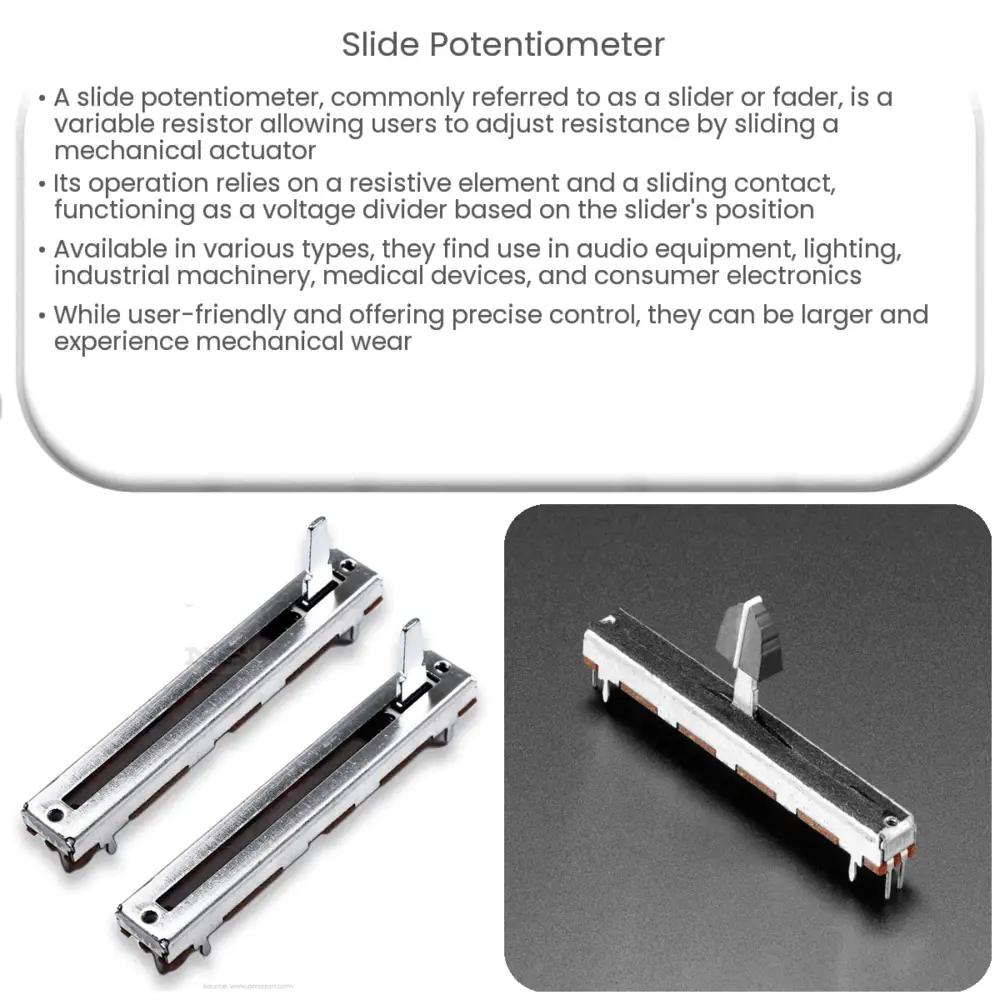A slide potentiometer is a variable resistor that adjusts resistance in a circuit by sliding a wiper along a linear track, used in audio, lighting, and more.

Slide Potentiometer: An Introduction and Its Applications
A slide potentiometer, also known as a slider, fader, or linear potentiometer, is a type of variable resistor that enables users to adjust the resistance within an electronic circuit by sliding a mechanical actuator along a linear path. This versatile component is widely used in various industries and applications, ranging from audio equipment to industrial machinery. In this article, we will delve into the fundamentals of slide potentiometers, their construction, and typical applications.
How Slide Potentiometers Work
At its core, a slide potentiometer is comprised of a resistive element, a sliding contact (also called a wiper), and a mechanical actuator. The resistive element, usually made of carbon or metal, forms a linear track that determines the total resistance of the potentiometer. The wiper, which is connected to the slider, moves along the track as the slider is manipulated, effectively altering the resistance between the wiper and the two ends of the resistive element.
The resistance between the wiper and one end of the track is inversely proportional to the resistance between the wiper and the other end. In other words, as the wiper is moved closer to one end of the track, the resistance between the wiper and that end decreases, while the resistance between the wiper and the other end increases. This property allows slide potentiometers to function as voltage dividers, providing a variable output voltage based on the position of the slider.
Construction and Types
Slide potentiometers are available in various sizes, shapes, and configurations, depending on the specific application requirements. The most common types of slide potentiometers are:
- Standard Linear Potentiometers: These potentiometers are designed with a straight, linear track and are the most widely used type. They offer a smooth, continuous adjustment and are suitable for applications requiring precise control.
- Logarithmic Potentiometers: Also known as audio taper potentiometers, these devices have a non-linear resistive element that produces a logarithmic change in resistance as the slider moves along the track. They are commonly used in audio equipment, as the human perception of sound is logarithmic.
- Dual Slide Potentiometers: These potentiometers feature two independent sliders on a single resistive element, allowing for simultaneous control of two separate circuits. They are often used in stereo audio applications and mixing consoles.
Additionally, slide potentiometers can be constructed using various materials for the resistive element, such as carbon, conductive plastic, or metal. Each material offers unique advantages in terms of durability, linearity, and temperature stability, making them suitable for different applications.
Common Applications
Slide potentiometers are employed in a wide array of applications due to their versatility and ease of use. Some common applications include:
- Audio Equipment: Slide potentiometers are frequently used in mixing consoles, equalizers, and volume controls for their smooth, continuous adjustment and ability to provide precise control over audio signals.
- Lighting Control: In lighting systems, slide potentiometers are used to adjust the intensity of lights, enabling users to create custom lighting effects and scenes.
Industrial Machinery and Automation
In industrial settings, slide potentiometers are often used as position feedback devices for machinery and automated systems. They provide precise, continuous control of variables such as speed, position, and force, enabling operators to fine-tune the performance of the system for optimal results.
Medical Devices
Medical equipment, such as infusion pumps and ventilators, utilize slide potentiometers to accurately control the delivery of fluids, gases, or medications. The precision and smooth operation of slide potentiometers are essential for maintaining safe and accurate dosing in these critical applications.
Consumer Electronics
Slide potentiometers are commonly found in consumer electronics, such as gaming controllers, where they are used to adjust settings like volume, brightness, and sensitivity. Their user-friendly design and reliable performance make them well-suited for these types of applications.
Advantages and Disadvantages
Slide potentiometers offer several advantages over other types of variable resistors, such as rotary potentiometers. Some of these advantages include:
- Easy to use: The linear movement of a slide potentiometer makes it intuitive and easy to use, even for users who are unfamiliar with electronics.
- Visual feedback: The position of the slider provides immediate visual feedback, allowing users to quickly gauge the current setting without the need for additional indicators.
- Precise control: Slide potentiometers offer smooth, continuous adjustment, enabling precise control over a wide range of values.
However, slide potentiometers also have some disadvantages:
- Size: Due to their linear design, slide potentiometers can require more space than rotary potentiometers, making them less suitable for compact applications.
- Mechanical wear: The sliding action of the wiper can cause mechanical wear over time, leading to decreased performance and eventual failure. This issue can be mitigated by using higher-quality materials and proper maintenance.
Conclusion
Slide potentiometers are versatile and user-friendly components that can be found in a wide range of industries and applications. Their ease of use, precise control, and visual feedback make them an attractive choice for designers and engineers looking to implement adjustable resistance in their projects. While they have some disadvantages, such as size and mechanical wear, the benefits often outweigh these drawbacks for many applications. By understanding the fundamentals, construction, and common uses of slide potentiometers, you can make informed decisions when selecting and implementing these components in your projects.

